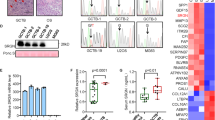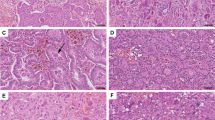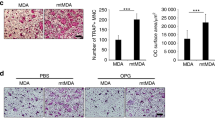Abstract
The origin and nature of osteoclast-like multinucleated giant cells (OMGCs), in extraskeletal neoplasms, is uncertain. The ultrastructure, antigenic phenotype and function of OMGCsm in a breast carcinoma were studied in order to clarify the relationship between OMGCs, osteoclasts and other cells of the mononuclear phagocyte system (MPS). OMGCs resorbed cortical bone in a manner similar to osteoclasts. However, unlike osteoclasts, OMGCs did not possess a ruffled border or clear zone, and expressed HLA-DR and Fc receptors and CD14, CD16, CD18 and CD11 (p150,95) antigens. In addition, OMGCs failed to respond morphologically to calcitonin and were directly stimulated by parathyroid hormone (PTH) to increase bone resorption. These findings suggest that OMGCs are a specific type of macrophage polykaryon distinct from both osteoclasts and other types of inflammatory polykaryon. Occasional smaller (20-25 microns) macrophage-like cells were also associated with resorption pits. Bone resorption by OMGCs isolated from the breast indicates that a cell of the MPS can be transplanted to a new tissue location and perform a highly specialised function appropriate to an MPS cell of that tissue (i.e. the osteoclast). PTH stimulation of bone resorption by OMGCs suggests that PTH or a PTH-like protein, may be involved in the bone resorption and consequent hypercalcaemia associated with metastatic breast cancer.
This is a preview of subscription content, access via your institution
Access options
Subscribe to this journal
Receive 24 print issues and online access
$259.00 per year
only $10.79 per issue
Buy this article
- Purchase on Springer Link
- Instant access to full article PDF
Prices may be subject to local taxes which are calculated during checkout
Similar content being viewed by others
Author information
Authors and Affiliations
Rights and permissions
About this article
Cite this article
Athanasou, N., Wells, C., Quinn, J. et al. The origin and nature of stromal osteoclast-like multinucleated giant cells in breast carcinoma: implications for tumour osteolysis and macrophage biology. Br J Cancer 59, 491–498 (1989). https://doi.org/10.1038/bjc.1989.102
Issue Date:
DOI: https://doi.org/10.1038/bjc.1989.102
This article is cited by
-
Invasive ductal carcinoma of the breast with osteoclast-like giant cells and clear cell features: a case report of a novel finding and review of the literature
World Journal of Surgical Oncology (2016)
-
Immunohistochemical evaluation of a sarcomatoid hepatocellular carcinoma with osteoclastlike giant cells
Diagnostic Pathology (2015)
-
Invasive breast carcinomas of no special type with osteoclast-like giant cells frequently have a luminal phenotype
Virchows Archiv (2014)
-
Multifocal invasive ductal breast cancer with osteoclast-like giant cells: a case report
Journal of Medical Case Reports (2011)
-
Surgically resected undifferentiated carcinoma with osteoclast-like giant cells of the periampullary region involving the orifice of the papilla of vater: Report of a case
Surgery Today (2010)



